The Role of Clay and Bricks in Interior Design: A Detailed Analysis
VerifiedAdded on 2022/12/20
|12
|2311
|87
Report
AI Summary
This report provides a comprehensive overview of the application of clay and bricks in interior design. It begins with an introduction to material processing and its significance, focusing specifically on clay and bricks. The report delves into the origin and properties of clay, its applications in interior architecture, and its impact on culture and society. It then explores the history, manufacturing processes, and applications of bricks in interior design, highlighting their role in shaping culture. The second part of the report emphasizes the importance of using clay and bricks as construction materials for interior design, discussing their versatility, energy efficiency, durability, aesthetic qualities, and sustainability. It further details the benefits of using bricks, such as cost-effectiveness, weatherproof qualities, and creative design possibilities. The report concludes by emphasizing the value of these materials in creating functional and aesthetically pleasing interior spaces.
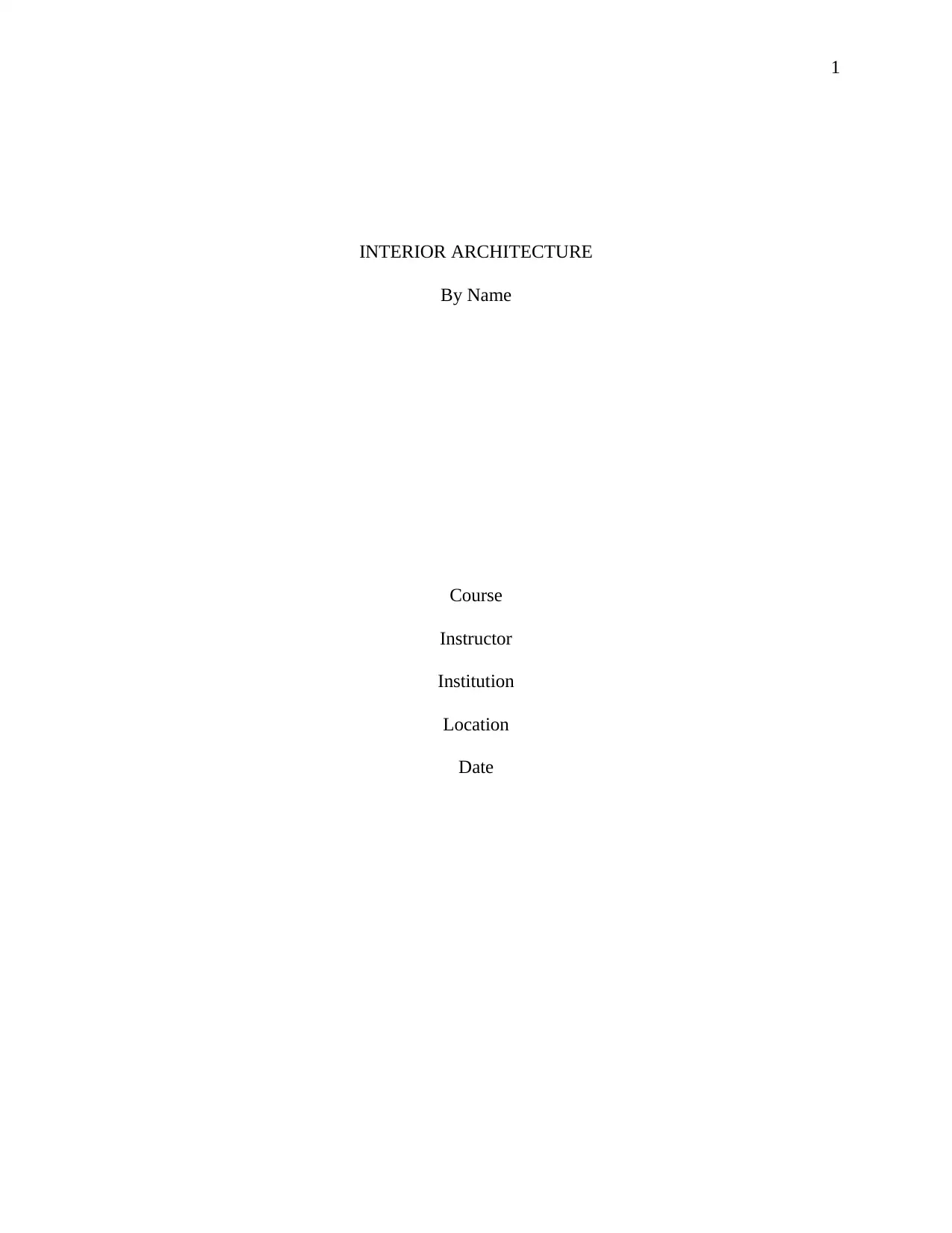
1
INTERIOR ARCHITECTURE
By Name
Course
Instructor
Institution
Location
Date
INTERIOR ARCHITECTURE
By Name
Course
Instructor
Institution
Location
Date
Paraphrase This Document
Need a fresh take? Get an instant paraphrase of this document with our AI Paraphraser
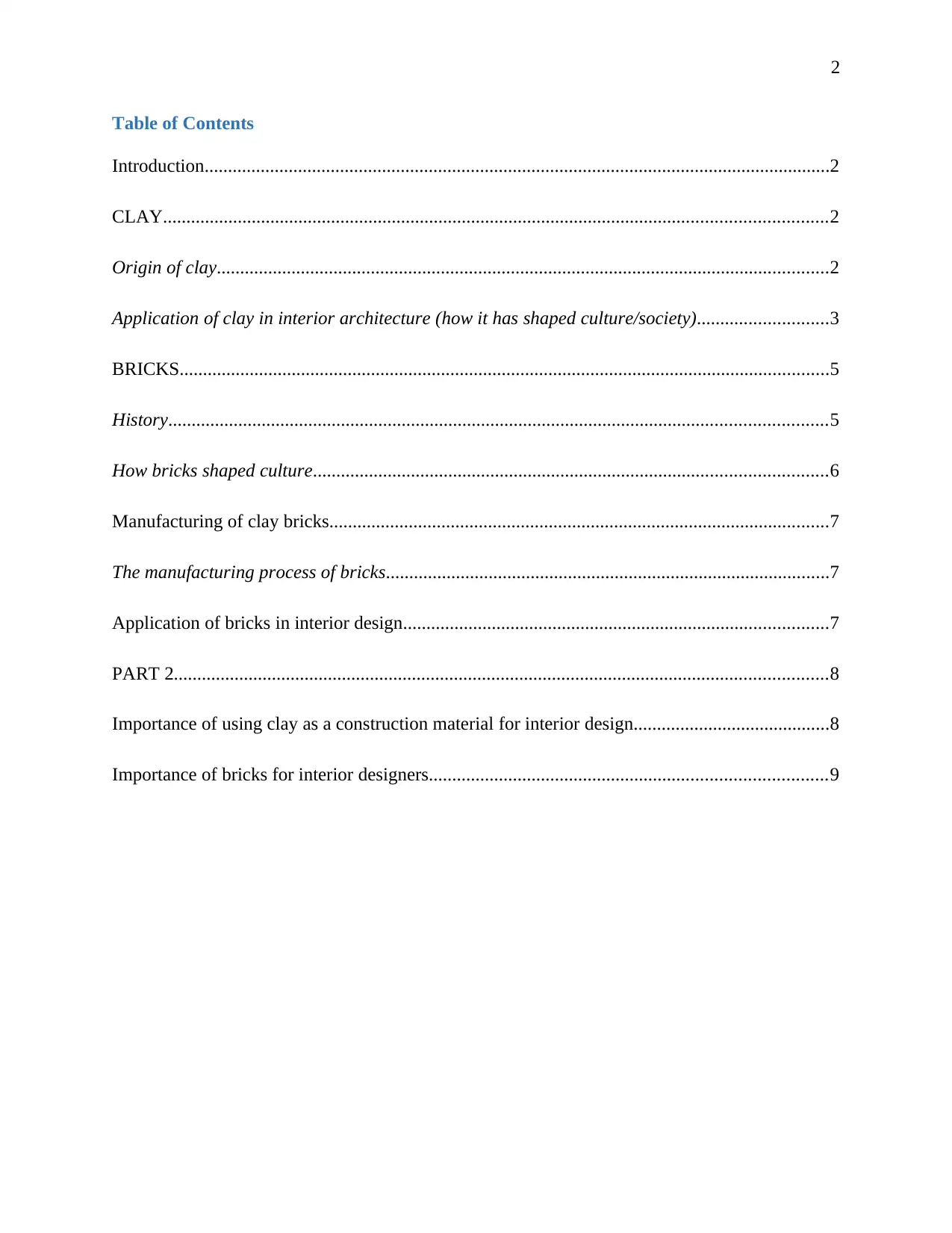
2
Table of Contents
Introduction......................................................................................................................................2
CLAY..............................................................................................................................................2
Origin of clay...................................................................................................................................2
Application of clay in interior architecture (how it has shaped culture/society)............................3
BRICKS...........................................................................................................................................5
History.............................................................................................................................................5
How bricks shaped culture..............................................................................................................6
Manufacturing of clay bricks...........................................................................................................7
The manufacturing process of bricks...............................................................................................7
Application of bricks in interior design...........................................................................................7
PART 2............................................................................................................................................8
Importance of using clay as a construction material for interior design..........................................8
Importance of bricks for interior designers.....................................................................................9
Table of Contents
Introduction......................................................................................................................................2
CLAY..............................................................................................................................................2
Origin of clay...................................................................................................................................2
Application of clay in interior architecture (how it has shaped culture/society)............................3
BRICKS...........................................................................................................................................5
History.............................................................................................................................................5
How bricks shaped culture..............................................................................................................6
Manufacturing of clay bricks...........................................................................................................7
The manufacturing process of bricks...............................................................................................7
Application of bricks in interior design...........................................................................................7
PART 2............................................................................................................................................8
Importance of using clay as a construction material for interior design..........................................8
Importance of bricks for interior designers.....................................................................................9
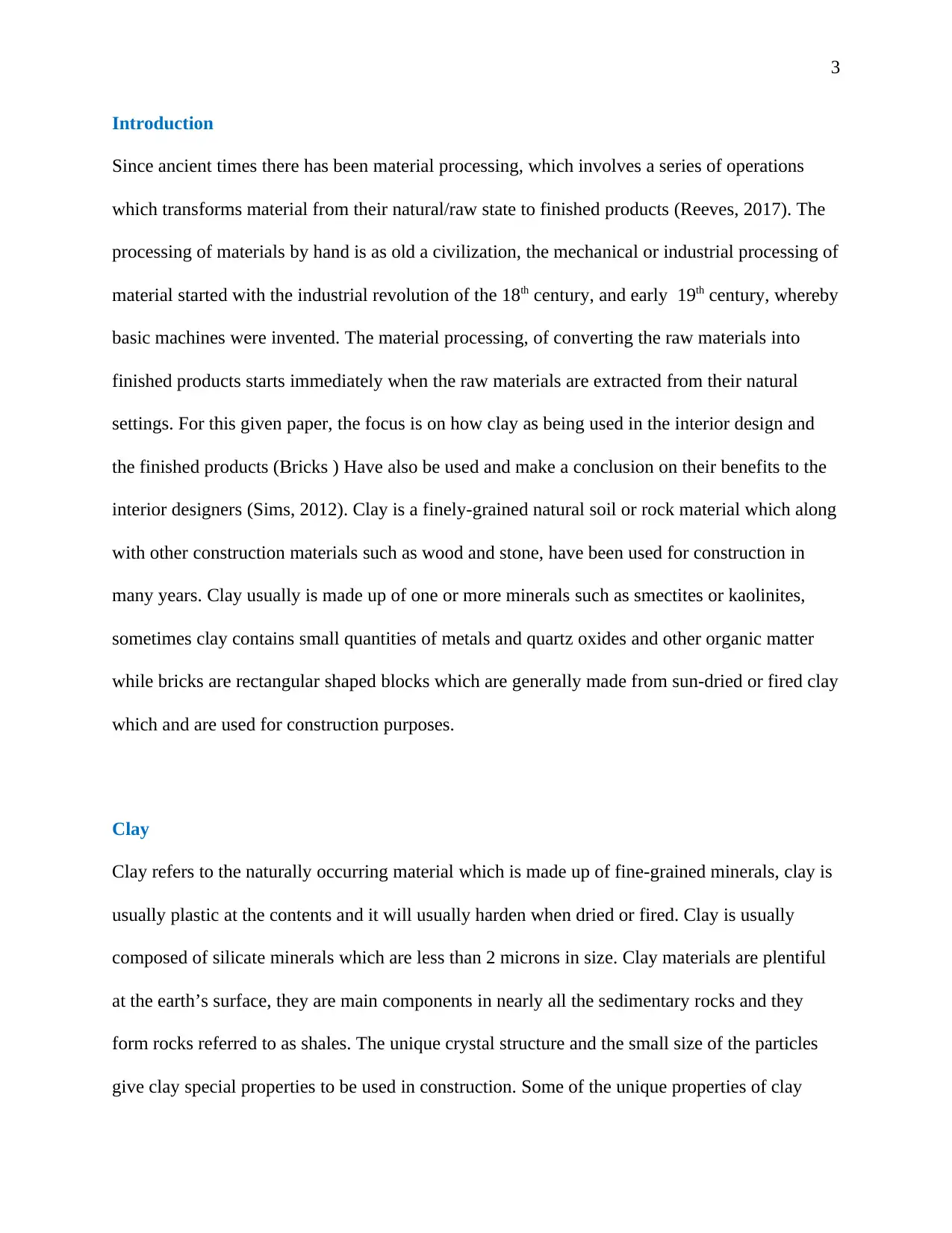
3
Introduction
Since ancient times there has been material processing, which involves a series of operations
which transforms material from their natural/raw state to finished products (Reeves, 2017). The
processing of materials by hand is as old a civilization, the mechanical or industrial processing of
material started with the industrial revolution of the 18th century, and early 19th century, whereby
basic machines were invented. The material processing, of converting the raw materials into
finished products starts immediately when the raw materials are extracted from their natural
settings. For this given paper, the focus is on how clay as being used in the interior design and
the finished products (Bricks ) Have also be used and make a conclusion on their benefits to the
interior designers (Sims, 2012). Clay is a finely-grained natural soil or rock material which along
with other construction materials such as wood and stone, have been used for construction in
many years. Clay usually is made up of one or more minerals such as smectites or kaolinites,
sometimes clay contains small quantities of metals and quartz oxides and other organic matter
while bricks are rectangular shaped blocks which are generally made from sun-dried or fired clay
which and are used for construction purposes.
Clay
Clay refers to the naturally occurring material which is made up of fine-grained minerals, clay is
usually plastic at the contents and it will usually harden when dried or fired. Clay is usually
composed of silicate minerals which are less than 2 microns in size. Clay materials are plentiful
at the earth’s surface, they are main components in nearly all the sedimentary rocks and they
form rocks referred to as shales. The unique crystal structure and the small size of the particles
give clay special properties to be used in construction. Some of the unique properties of clay
Introduction
Since ancient times there has been material processing, which involves a series of operations
which transforms material from their natural/raw state to finished products (Reeves, 2017). The
processing of materials by hand is as old a civilization, the mechanical or industrial processing of
material started with the industrial revolution of the 18th century, and early 19th century, whereby
basic machines were invented. The material processing, of converting the raw materials into
finished products starts immediately when the raw materials are extracted from their natural
settings. For this given paper, the focus is on how clay as being used in the interior design and
the finished products (Bricks ) Have also be used and make a conclusion on their benefits to the
interior designers (Sims, 2012). Clay is a finely-grained natural soil or rock material which along
with other construction materials such as wood and stone, have been used for construction in
many years. Clay usually is made up of one or more minerals such as smectites or kaolinites,
sometimes clay contains small quantities of metals and quartz oxides and other organic matter
while bricks are rectangular shaped blocks which are generally made from sun-dried or fired clay
which and are used for construction purposes.
Clay
Clay refers to the naturally occurring material which is made up of fine-grained minerals, clay is
usually plastic at the contents and it will usually harden when dried or fired. Clay is usually
composed of silicate minerals which are less than 2 microns in size. Clay materials are plentiful
at the earth’s surface, they are main components in nearly all the sedimentary rocks and they
form rocks referred to as shales. The unique crystal structure and the small size of the particles
give clay special properties to be used in construction. Some of the unique properties of clay
⊘ This is a preview!⊘
Do you want full access?
Subscribe today to unlock all pages.

Trusted by 1+ million students worldwide
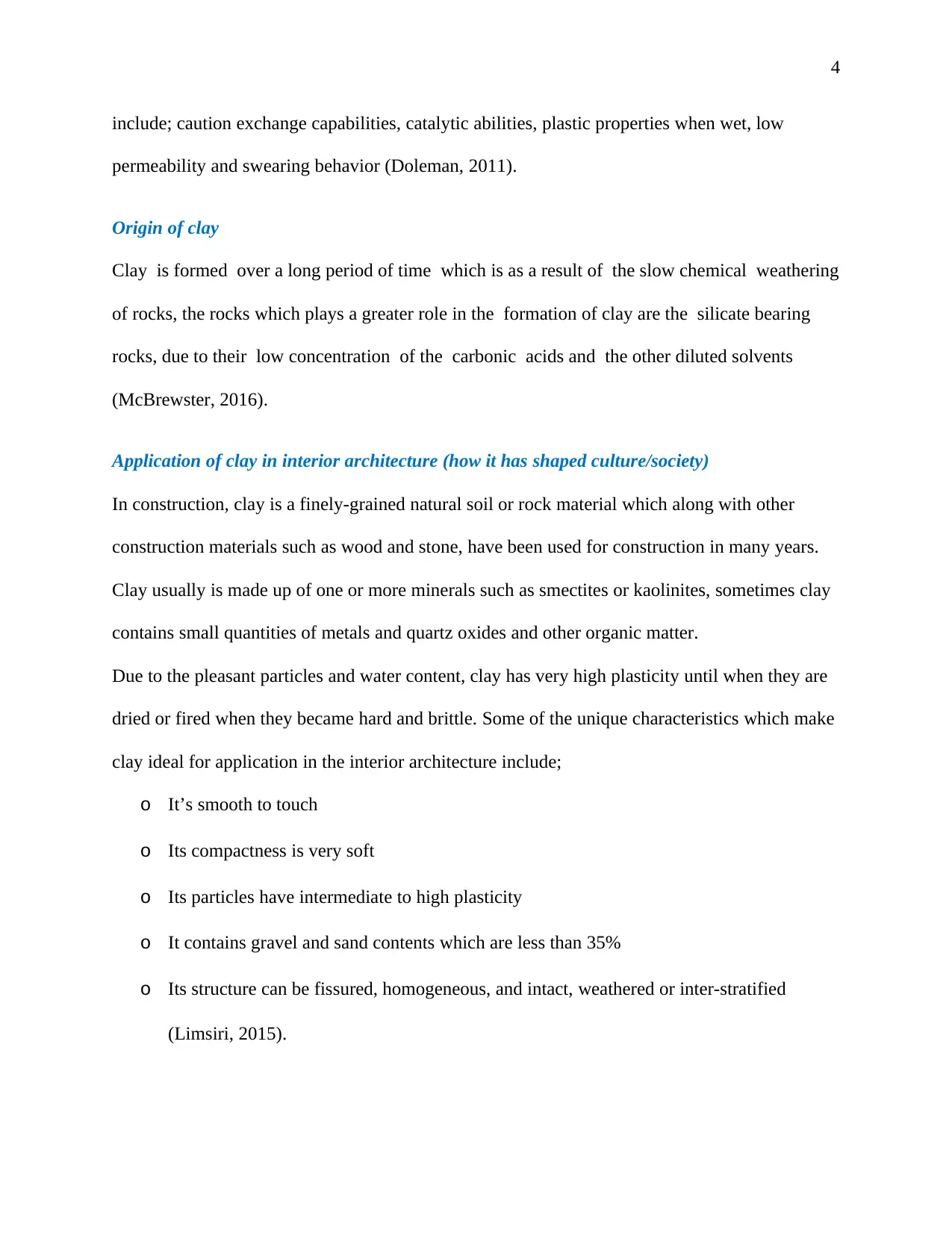
4
include; caution exchange capabilities, catalytic abilities, plastic properties when wet, low
permeability and swearing behavior (Doleman, 2011).
Origin of clay
Clay is formed over a long period of time which is as a result of the slow chemical weathering
of rocks, the rocks which plays a greater role in the formation of clay are the silicate bearing
rocks, due to their low concentration of the carbonic acids and the other diluted solvents
(McBrewster, 2016).
Application of clay in interior architecture (how it has shaped culture/society)
In construction, clay is a finely-grained natural soil or rock material which along with other
construction materials such as wood and stone, have been used for construction in many years.
Clay usually is made up of one or more minerals such as smectites or kaolinites, sometimes clay
contains small quantities of metals and quartz oxides and other organic matter.
Due to the pleasant particles and water content, clay has very high plasticity until when they are
dried or fired when they became hard and brittle. Some of the unique characteristics which make
clay ideal for application in the interior architecture include;
o It’s smooth to touch
o Its compactness is very soft
o Its particles have intermediate to high plasticity
o It contains gravel and sand contents which are less than 35%
o Its structure can be fissured, homogeneous, and intact, weathered or inter-stratified
(Limsiri, 2015).
include; caution exchange capabilities, catalytic abilities, plastic properties when wet, low
permeability and swearing behavior (Doleman, 2011).
Origin of clay
Clay is formed over a long period of time which is as a result of the slow chemical weathering
of rocks, the rocks which plays a greater role in the formation of clay are the silicate bearing
rocks, due to their low concentration of the carbonic acids and the other diluted solvents
(McBrewster, 2016).
Application of clay in interior architecture (how it has shaped culture/society)
In construction, clay is a finely-grained natural soil or rock material which along with other
construction materials such as wood and stone, have been used for construction in many years.
Clay usually is made up of one or more minerals such as smectites or kaolinites, sometimes clay
contains small quantities of metals and quartz oxides and other organic matter.
Due to the pleasant particles and water content, clay has very high plasticity until when they are
dried or fired when they became hard and brittle. Some of the unique characteristics which make
clay ideal for application in the interior architecture include;
o It’s smooth to touch
o Its compactness is very soft
o Its particles have intermediate to high plasticity
o It contains gravel and sand contents which are less than 35%
o Its structure can be fissured, homogeneous, and intact, weathered or inter-stratified
(Limsiri, 2015).
Paraphrase This Document
Need a fresh take? Get an instant paraphrase of this document with our AI Paraphraser
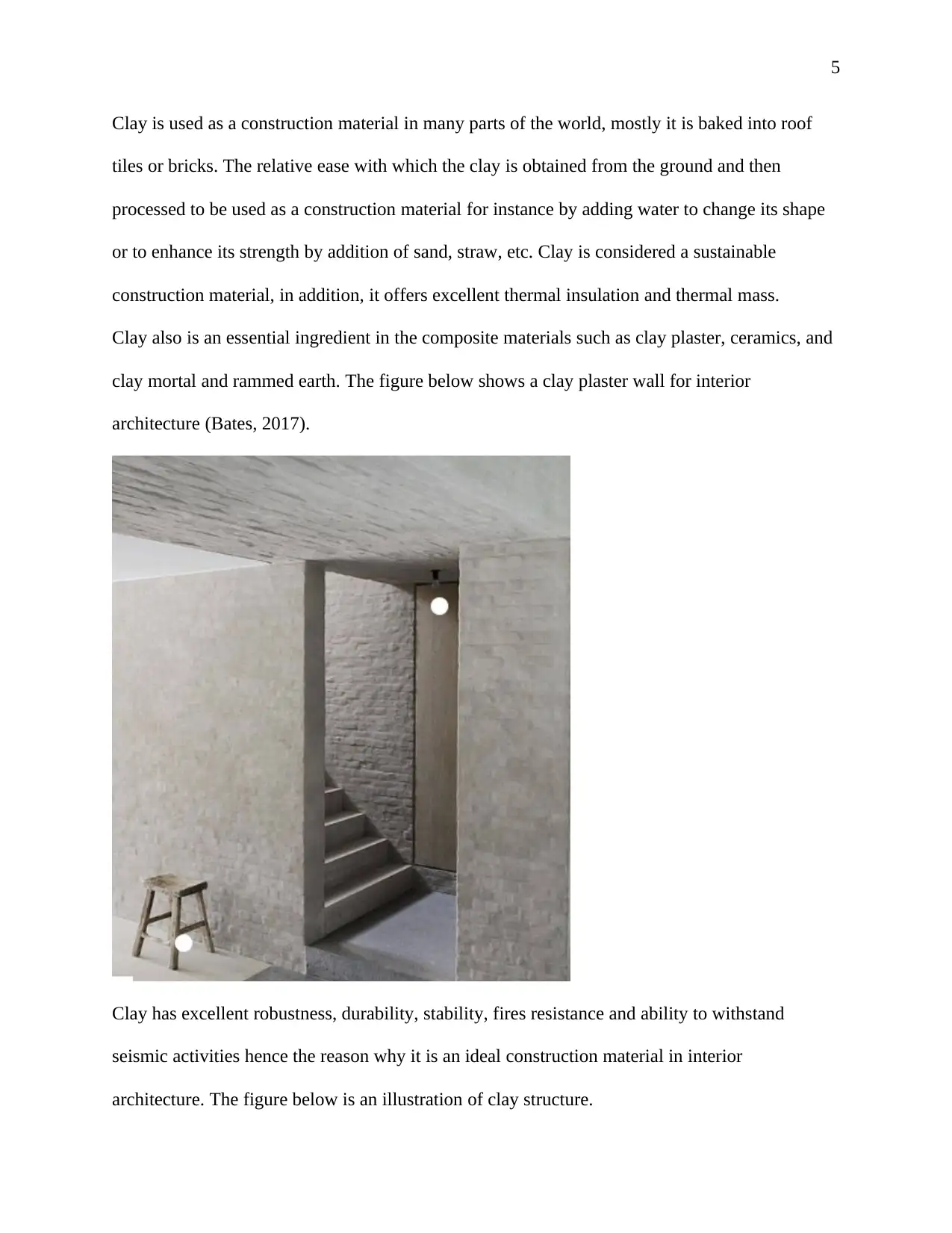
5
Clay is used as a construction material in many parts of the world, mostly it is baked into roof
tiles or bricks. The relative ease with which the clay is obtained from the ground and then
processed to be used as a construction material for instance by adding water to change its shape
or to enhance its strength by addition of sand, straw, etc. Clay is considered a sustainable
construction material, in addition, it offers excellent thermal insulation and thermal mass.
Clay also is an essential ingredient in the composite materials such as clay plaster, ceramics, and
clay mortal and rammed earth. The figure below shows a clay plaster wall for interior
architecture (Bates, 2017).
Clay has excellent robustness, durability, stability, fires resistance and ability to withstand
seismic activities hence the reason why it is an ideal construction material in interior
architecture. The figure below is an illustration of clay structure.
Clay is used as a construction material in many parts of the world, mostly it is baked into roof
tiles or bricks. The relative ease with which the clay is obtained from the ground and then
processed to be used as a construction material for instance by adding water to change its shape
or to enhance its strength by addition of sand, straw, etc. Clay is considered a sustainable
construction material, in addition, it offers excellent thermal insulation and thermal mass.
Clay also is an essential ingredient in the composite materials such as clay plaster, ceramics, and
clay mortal and rammed earth. The figure below shows a clay plaster wall for interior
architecture (Bates, 2017).
Clay has excellent robustness, durability, stability, fires resistance and ability to withstand
seismic activities hence the reason why it is an ideal construction material in interior
architecture. The figure below is an illustration of clay structure.
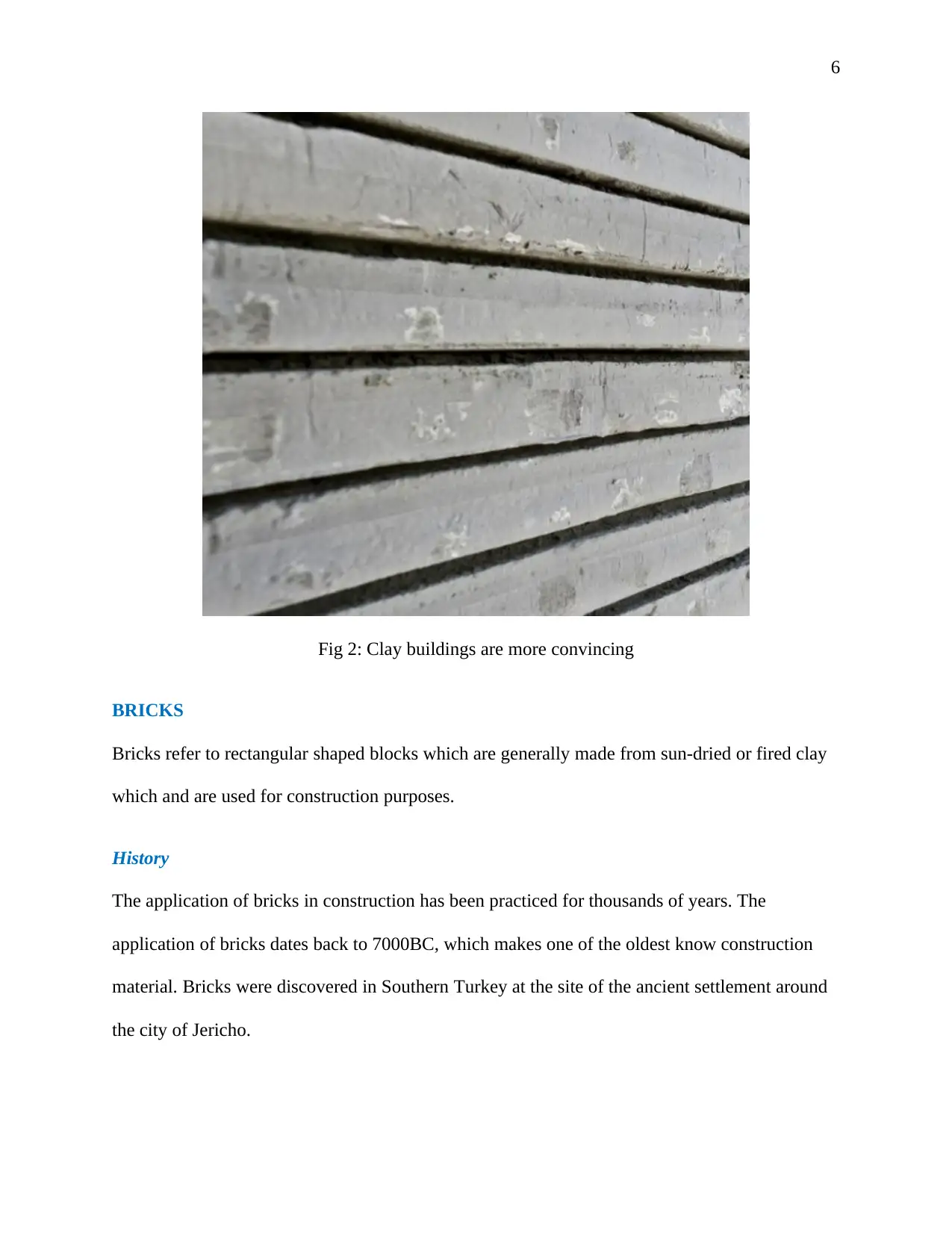
6
Fig 2: Clay buildings are more convincing
BRICKS
Bricks refer to rectangular shaped blocks which are generally made from sun-dried or fired clay
which and are used for construction purposes.
History
The application of bricks in construction has been practiced for thousands of years. The
application of bricks dates back to 7000BC, which makes one of the oldest know construction
material. Bricks were discovered in Southern Turkey at the site of the ancient settlement around
the city of Jericho.
Fig 2: Clay buildings are more convincing
BRICKS
Bricks refer to rectangular shaped blocks which are generally made from sun-dried or fired clay
which and are used for construction purposes.
History
The application of bricks in construction has been practiced for thousands of years. The
application of bricks dates back to 7000BC, which makes one of the oldest know construction
material. Bricks were discovered in Southern Turkey at the site of the ancient settlement around
the city of Jericho.
⊘ This is a preview!⊘
Do you want full access?
Subscribe today to unlock all pages.

Trusted by 1+ million students worldwide
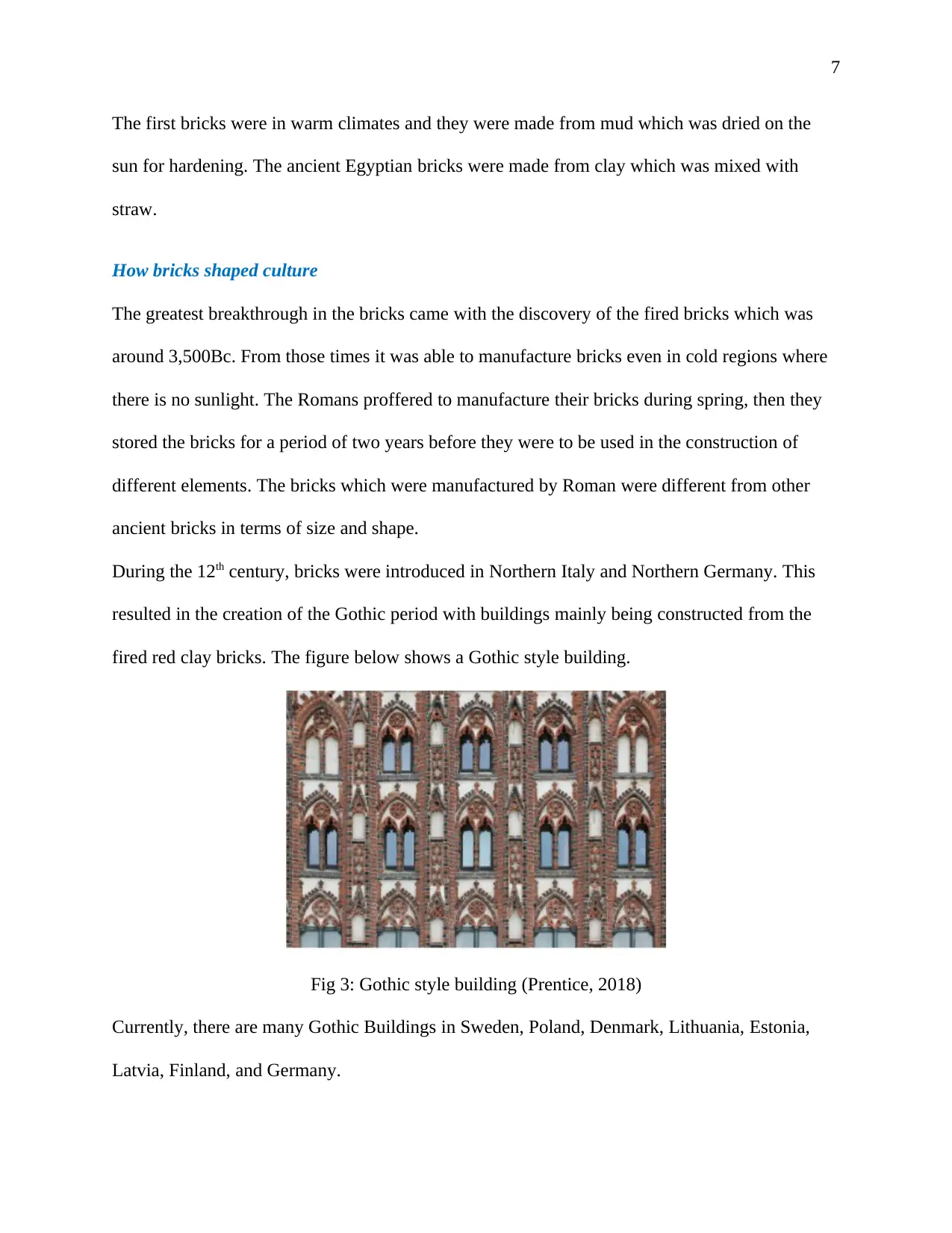
7
The first bricks were in warm climates and they were made from mud which was dried on the
sun for hardening. The ancient Egyptian bricks were made from clay which was mixed with
straw.
How bricks shaped culture
The greatest breakthrough in the bricks came with the discovery of the fired bricks which was
around 3,500Bc. From those times it was able to manufacture bricks even in cold regions where
there is no sunlight. The Romans proffered to manufacture their bricks during spring, then they
stored the bricks for a period of two years before they were to be used in the construction of
different elements. The bricks which were manufactured by Roman were different from other
ancient bricks in terms of size and shape.
During the 12th century, bricks were introduced in Northern Italy and Northern Germany. This
resulted in the creation of the Gothic period with buildings mainly being constructed from the
fired red clay bricks. The figure below shows a Gothic style building.
Fig 3: Gothic style building (Prentice, 2018)
Currently, there are many Gothic Buildings in Sweden, Poland, Denmark, Lithuania, Estonia,
Latvia, Finland, and Germany.
The first bricks were in warm climates and they were made from mud which was dried on the
sun for hardening. The ancient Egyptian bricks were made from clay which was mixed with
straw.
How bricks shaped culture
The greatest breakthrough in the bricks came with the discovery of the fired bricks which was
around 3,500Bc. From those times it was able to manufacture bricks even in cold regions where
there is no sunlight. The Romans proffered to manufacture their bricks during spring, then they
stored the bricks for a period of two years before they were to be used in the construction of
different elements. The bricks which were manufactured by Roman were different from other
ancient bricks in terms of size and shape.
During the 12th century, bricks were introduced in Northern Italy and Northern Germany. This
resulted in the creation of the Gothic period with buildings mainly being constructed from the
fired red clay bricks. The figure below shows a Gothic style building.
Fig 3: Gothic style building (Prentice, 2018)
Currently, there are many Gothic Buildings in Sweden, Poland, Denmark, Lithuania, Estonia,
Latvia, Finland, and Germany.
Paraphrase This Document
Need a fresh take? Get an instant paraphrase of this document with our AI Paraphraser
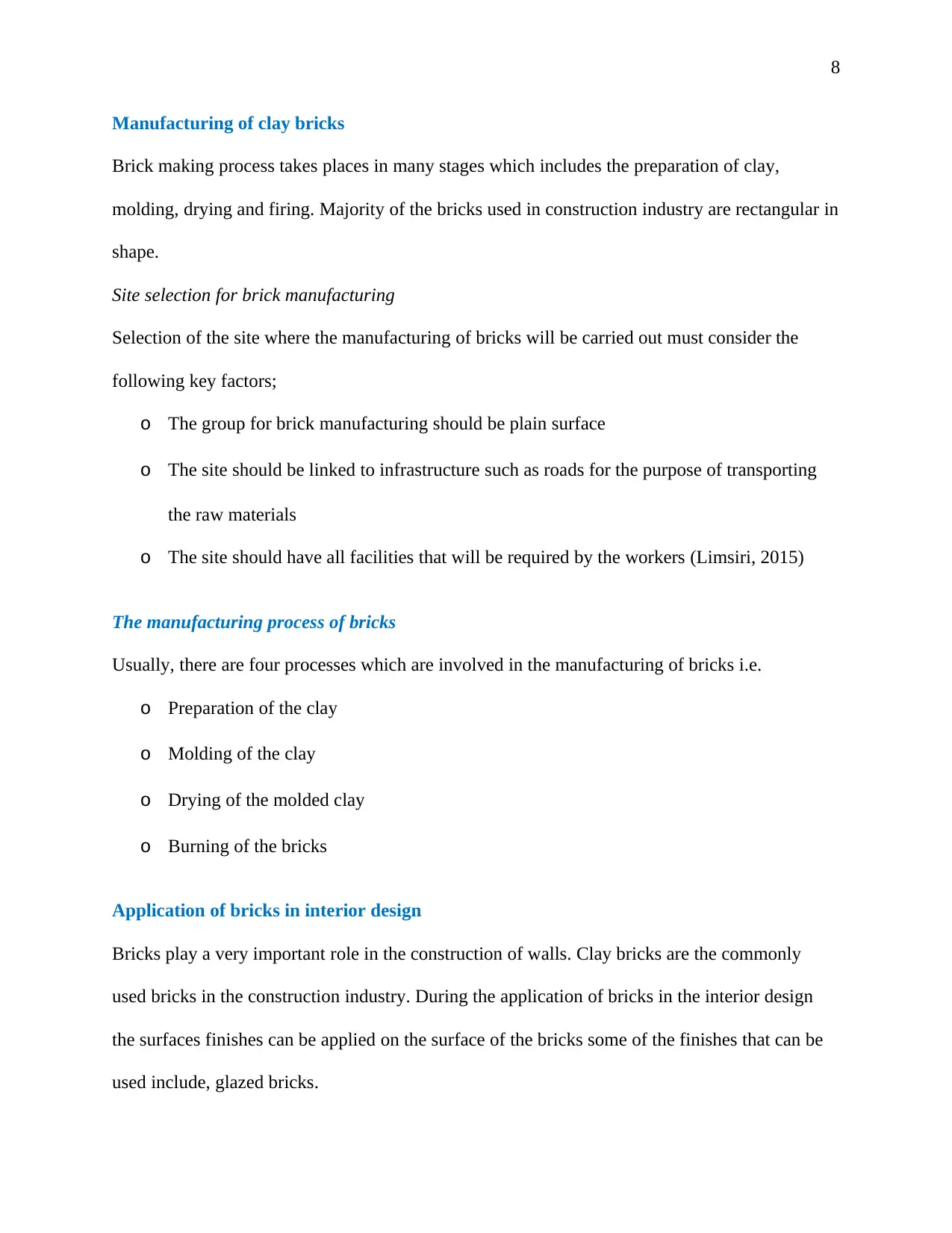
8
Manufacturing of clay bricks
Brick making process takes places in many stages which includes the preparation of clay,
molding, drying and firing. Majority of the bricks used in construction industry are rectangular in
shape.
Site selection for brick manufacturing
Selection of the site where the manufacturing of bricks will be carried out must consider the
following key factors;
o The group for brick manufacturing should be plain surface
o The site should be linked to infrastructure such as roads for the purpose of transporting
the raw materials
o The site should have all facilities that will be required by the workers (Limsiri, 2015)
The manufacturing process of bricks
Usually, there are four processes which are involved in the manufacturing of bricks i.e.
o Preparation of the clay
o Molding of the clay
o Drying of the molded clay
o Burning of the bricks
Application of bricks in interior design
Bricks play a very important role in the construction of walls. Clay bricks are the commonly
used bricks in the construction industry. During the application of bricks in the interior design
the surfaces finishes can be applied on the surface of the bricks some of the finishes that can be
used include, glazed bricks.
Manufacturing of clay bricks
Brick making process takes places in many stages which includes the preparation of clay,
molding, drying and firing. Majority of the bricks used in construction industry are rectangular in
shape.
Site selection for brick manufacturing
Selection of the site where the manufacturing of bricks will be carried out must consider the
following key factors;
o The group for brick manufacturing should be plain surface
o The site should be linked to infrastructure such as roads for the purpose of transporting
the raw materials
o The site should have all facilities that will be required by the workers (Limsiri, 2015)
The manufacturing process of bricks
Usually, there are four processes which are involved in the manufacturing of bricks i.e.
o Preparation of the clay
o Molding of the clay
o Drying of the molded clay
o Burning of the bricks
Application of bricks in interior design
Bricks play a very important role in the construction of walls. Clay bricks are the commonly
used bricks in the construction industry. During the application of bricks in the interior design
the surfaces finishes can be applied on the surface of the bricks some of the finishes that can be
used include, glazed bricks.
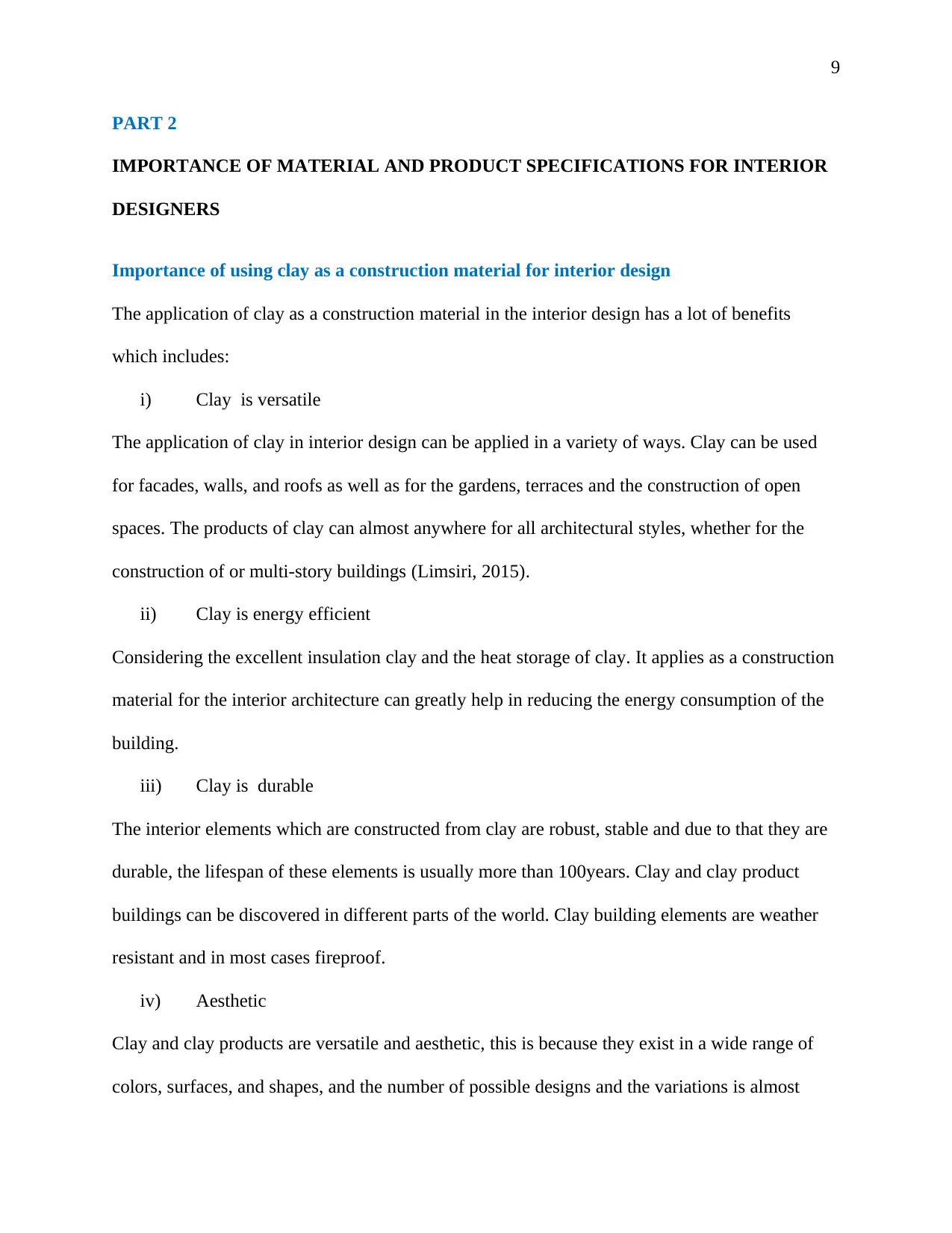
9
PART 2
IMPORTANCE OF MATERIAL AND PRODUCT SPECIFICATIONS FOR INTERIOR
DESIGNERS
Importance of using clay as a construction material for interior design
The application of clay as a construction material in the interior design has a lot of benefits
which includes:
i) Clay is versatile
The application of clay in interior design can be applied in a variety of ways. Clay can be used
for facades, walls, and roofs as well as for the gardens, terraces and the construction of open
spaces. The products of clay can almost anywhere for all architectural styles, whether for the
construction of or multi-story buildings (Limsiri, 2015).
ii) Clay is energy efficient
Considering the excellent insulation clay and the heat storage of clay. It applies as a construction
material for the interior architecture can greatly help in reducing the energy consumption of the
building.
iii) Clay is durable
The interior elements which are constructed from clay are robust, stable and due to that they are
durable, the lifespan of these elements is usually more than 100years. Clay and clay product
buildings can be discovered in different parts of the world. Clay building elements are weather
resistant and in most cases fireproof.
iv) Aesthetic
Clay and clay products are versatile and aesthetic, this is because they exist in a wide range of
colors, surfaces, and shapes, and the number of possible designs and the variations is almost
PART 2
IMPORTANCE OF MATERIAL AND PRODUCT SPECIFICATIONS FOR INTERIOR
DESIGNERS
Importance of using clay as a construction material for interior design
The application of clay as a construction material in the interior design has a lot of benefits
which includes:
i) Clay is versatile
The application of clay in interior design can be applied in a variety of ways. Clay can be used
for facades, walls, and roofs as well as for the gardens, terraces and the construction of open
spaces. The products of clay can almost anywhere for all architectural styles, whether for the
construction of or multi-story buildings (Limsiri, 2015).
ii) Clay is energy efficient
Considering the excellent insulation clay and the heat storage of clay. It applies as a construction
material for the interior architecture can greatly help in reducing the energy consumption of the
building.
iii) Clay is durable
The interior elements which are constructed from clay are robust, stable and due to that they are
durable, the lifespan of these elements is usually more than 100years. Clay and clay product
buildings can be discovered in different parts of the world. Clay building elements are weather
resistant and in most cases fireproof.
iv) Aesthetic
Clay and clay products are versatile and aesthetic, this is because they exist in a wide range of
colors, surfaces, and shapes, and the number of possible designs and the variations is almost
⊘ This is a preview!⊘
Do you want full access?
Subscribe today to unlock all pages.

Trusted by 1+ million students worldwide
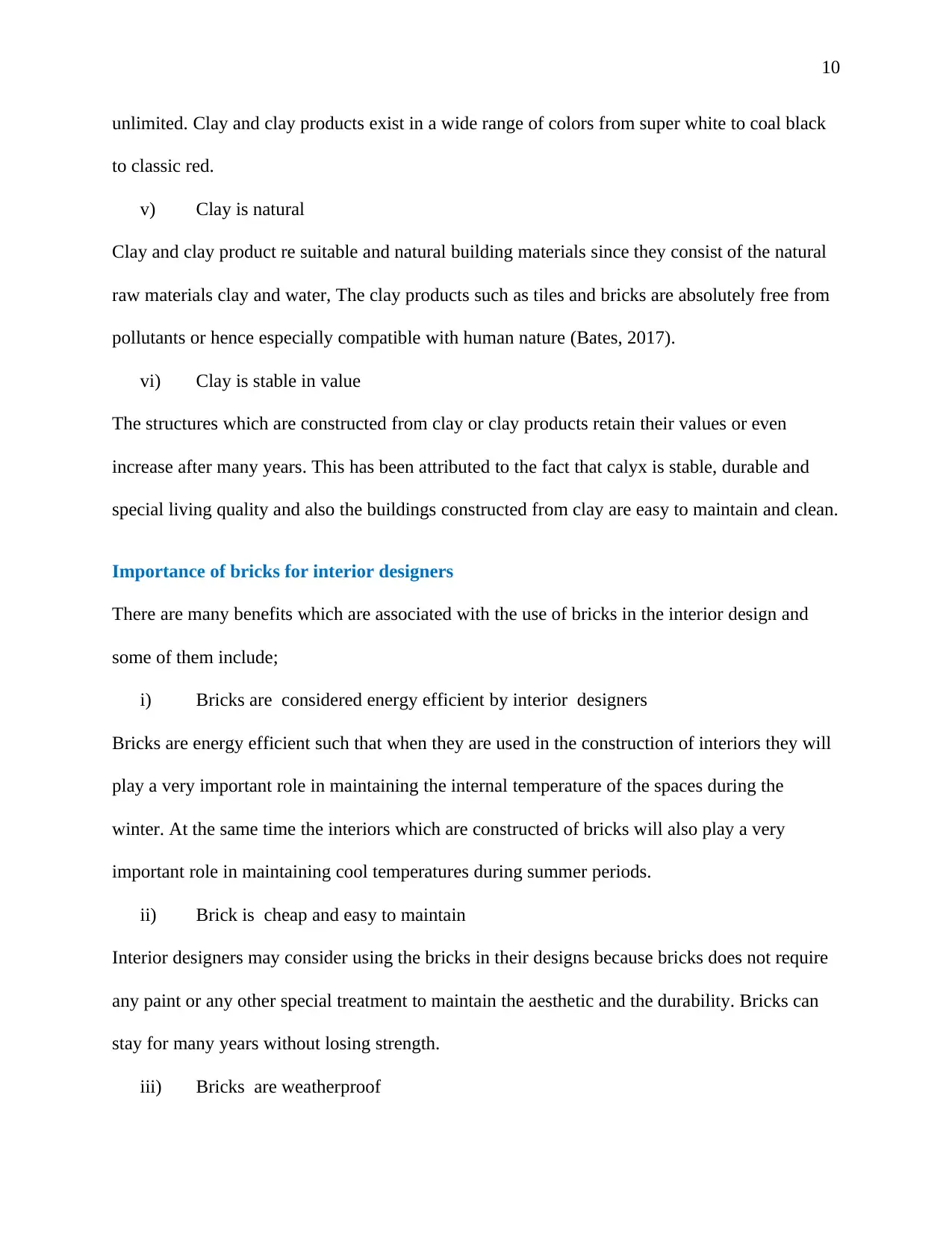
10
unlimited. Clay and clay products exist in a wide range of colors from super white to coal black
to classic red.
v) Clay is natural
Clay and clay product re suitable and natural building materials since they consist of the natural
raw materials clay and water, The clay products such as tiles and bricks are absolutely free from
pollutants or hence especially compatible with human nature (Bates, 2017).
vi) Clay is stable in value
The structures which are constructed from clay or clay products retain their values or even
increase after many years. This has been attributed to the fact that calyx is stable, durable and
special living quality and also the buildings constructed from clay are easy to maintain and clean.
Importance of bricks for interior designers
There are many benefits which are associated with the use of bricks in the interior design and
some of them include;
i) Bricks are considered energy efficient by interior designers
Bricks are energy efficient such that when they are used in the construction of interiors they will
play a very important role in maintaining the internal temperature of the spaces during the
winter. At the same time the interiors which are constructed of bricks will also play a very
important role in maintaining cool temperatures during summer periods.
ii) Brick is cheap and easy to maintain
Interior designers may consider using the bricks in their designs because bricks does not require
any paint or any other special treatment to maintain the aesthetic and the durability. Bricks can
stay for many years without losing strength.
iii) Bricks are weatherproof
unlimited. Clay and clay products exist in a wide range of colors from super white to coal black
to classic red.
v) Clay is natural
Clay and clay product re suitable and natural building materials since they consist of the natural
raw materials clay and water, The clay products such as tiles and bricks are absolutely free from
pollutants or hence especially compatible with human nature (Bates, 2017).
vi) Clay is stable in value
The structures which are constructed from clay or clay products retain their values or even
increase after many years. This has been attributed to the fact that calyx is stable, durable and
special living quality and also the buildings constructed from clay are easy to maintain and clean.
Importance of bricks for interior designers
There are many benefits which are associated with the use of bricks in the interior design and
some of them include;
i) Bricks are considered energy efficient by interior designers
Bricks are energy efficient such that when they are used in the construction of interiors they will
play a very important role in maintaining the internal temperature of the spaces during the
winter. At the same time the interiors which are constructed of bricks will also play a very
important role in maintaining cool temperatures during summer periods.
ii) Brick is cheap and easy to maintain
Interior designers may consider using the bricks in their designs because bricks does not require
any paint or any other special treatment to maintain the aesthetic and the durability. Bricks can
stay for many years without losing strength.
iii) Bricks are weatherproof
Paraphrase This Document
Need a fresh take? Get an instant paraphrase of this document with our AI Paraphraser
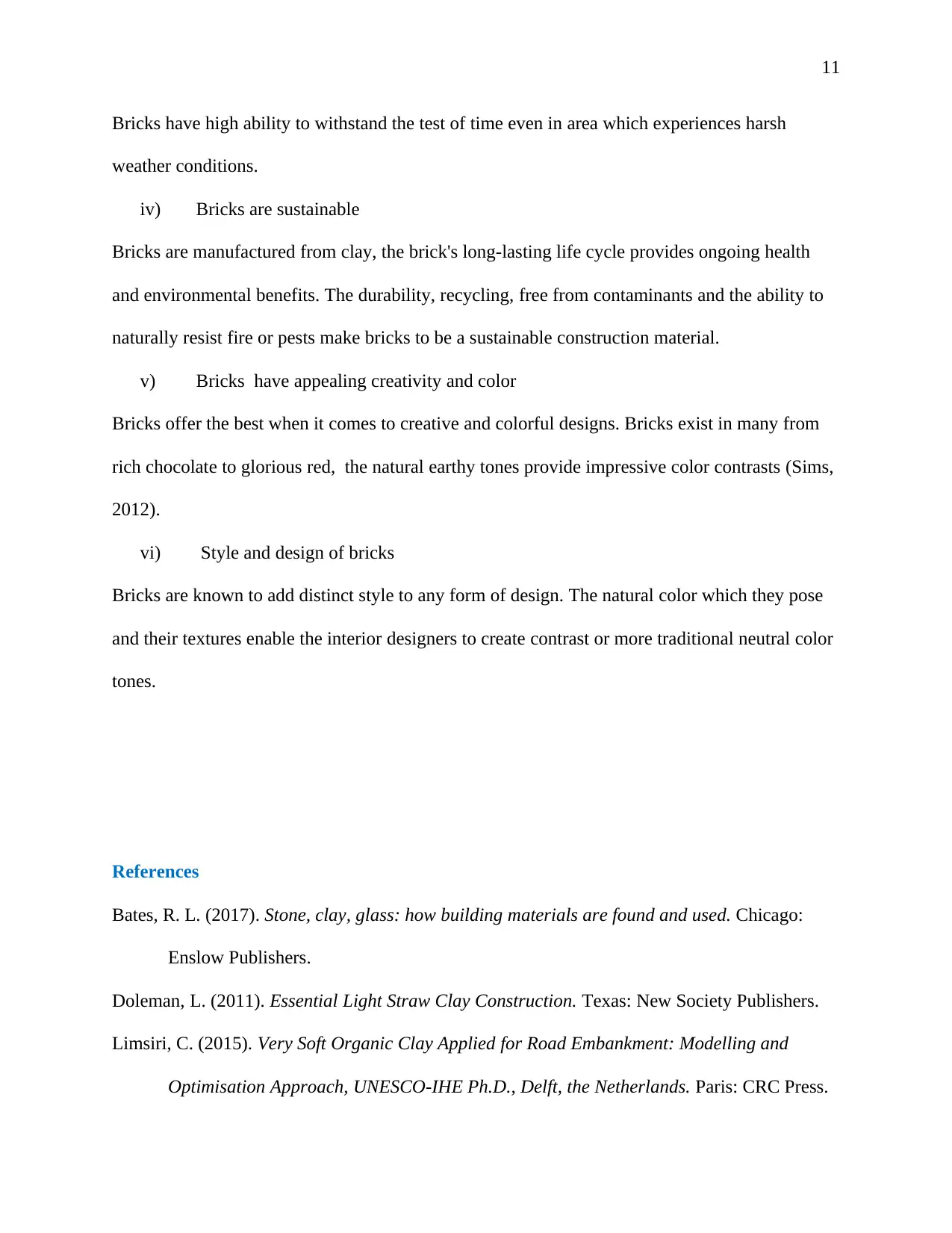
11
Bricks have high ability to withstand the test of time even in area which experiences harsh
weather conditions.
iv) Bricks are sustainable
Bricks are manufactured from clay, the brick's long-lasting life cycle provides ongoing health
and environmental benefits. The durability, recycling, free from contaminants and the ability to
naturally resist fire or pests make bricks to be a sustainable construction material.
v) Bricks have appealing creativity and color
Bricks offer the best when it comes to creative and colorful designs. Bricks exist in many from
rich chocolate to glorious red, the natural earthy tones provide impressive color contrasts (Sims,
2012).
vi) Style and design of bricks
Bricks are known to add distinct style to any form of design. The natural color which they pose
and their textures enable the interior designers to create contrast or more traditional neutral color
tones.
References
Bates, R. L. (2017). Stone, clay, glass: how building materials are found and used. Chicago:
Enslow Publishers.
Doleman, L. (2011). Essential Light Straw Clay Construction. Texas: New Society Publishers.
Limsiri, C. (2015). Very Soft Organic Clay Applied for Road Embankment: Modelling and
Optimisation Approach, UNESCO-IHE Ph.D., Delft, the Netherlands. Paris: CRC Press.
Bricks have high ability to withstand the test of time even in area which experiences harsh
weather conditions.
iv) Bricks are sustainable
Bricks are manufactured from clay, the brick's long-lasting life cycle provides ongoing health
and environmental benefits. The durability, recycling, free from contaminants and the ability to
naturally resist fire or pests make bricks to be a sustainable construction material.
v) Bricks have appealing creativity and color
Bricks offer the best when it comes to creative and colorful designs. Bricks exist in many from
rich chocolate to glorious red, the natural earthy tones provide impressive color contrasts (Sims,
2012).
vi) Style and design of bricks
Bricks are known to add distinct style to any form of design. The natural color which they pose
and their textures enable the interior designers to create contrast or more traditional neutral color
tones.
References
Bates, R. L. (2017). Stone, clay, glass: how building materials are found and used. Chicago:
Enslow Publishers.
Doleman, L. (2011). Essential Light Straw Clay Construction. Texas: New Society Publishers.
Limsiri, C. (2015). Very Soft Organic Clay Applied for Road Embankment: Modelling and
Optimisation Approach, UNESCO-IHE Ph.D., Delft, the Netherlands. Paris: CRC Press.
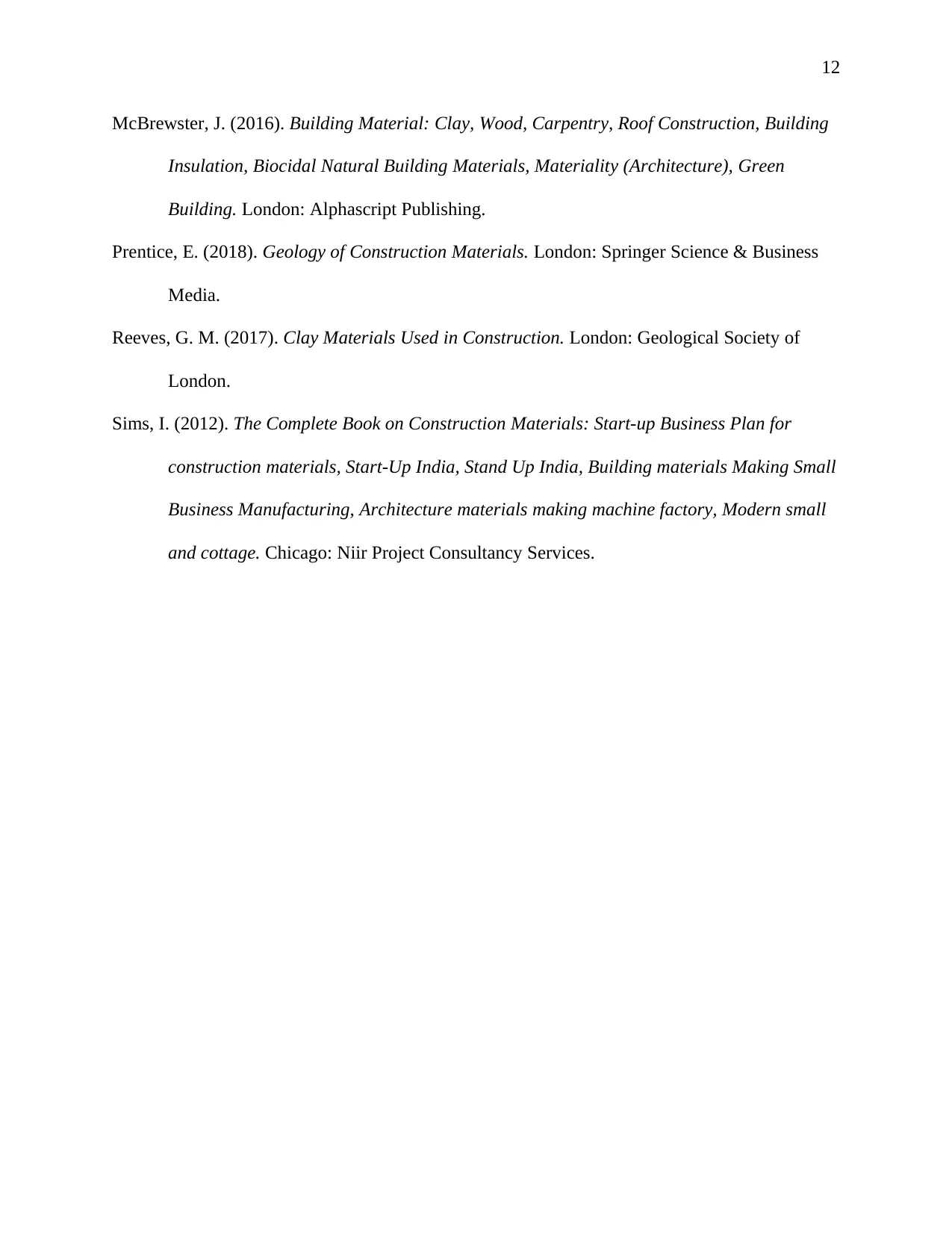
12
McBrewster, J. (2016). Building Material: Clay, Wood, Carpentry, Roof Construction, Building
Insulation, Biocidal Natural Building Materials, Materiality (Architecture), Green
Building. London: Alphascript Publishing.
Prentice, E. (2018). Geology of Construction Materials. London: Springer Science & Business
Media.
Reeves, G. M. (2017). Clay Materials Used in Construction. London: Geological Society of
London.
Sims, I. (2012). The Complete Book on Construction Materials: Start-up Business Plan for
construction materials, Start-Up India, Stand Up India, Building materials Making Small
Business Manufacturing, Architecture materials making machine factory, Modern small
and cottage. Chicago: Niir Project Consultancy Services.
McBrewster, J. (2016). Building Material: Clay, Wood, Carpentry, Roof Construction, Building
Insulation, Biocidal Natural Building Materials, Materiality (Architecture), Green
Building. London: Alphascript Publishing.
Prentice, E. (2018). Geology of Construction Materials. London: Springer Science & Business
Media.
Reeves, G. M. (2017). Clay Materials Used in Construction. London: Geological Society of
London.
Sims, I. (2012). The Complete Book on Construction Materials: Start-up Business Plan for
construction materials, Start-Up India, Stand Up India, Building materials Making Small
Business Manufacturing, Architecture materials making machine factory, Modern small
and cottage. Chicago: Niir Project Consultancy Services.
⊘ This is a preview!⊘
Do you want full access?
Subscribe today to unlock all pages.

Trusted by 1+ million students worldwide
1 out of 12
Related Documents
Your All-in-One AI-Powered Toolkit for Academic Success.
+13062052269
info@desklib.com
Available 24*7 on WhatsApp / Email
![[object Object]](/_next/static/media/star-bottom.7253800d.svg)
Unlock your academic potential
Copyright © 2020–2025 A2Z Services. All Rights Reserved. Developed and managed by ZUCOL.





